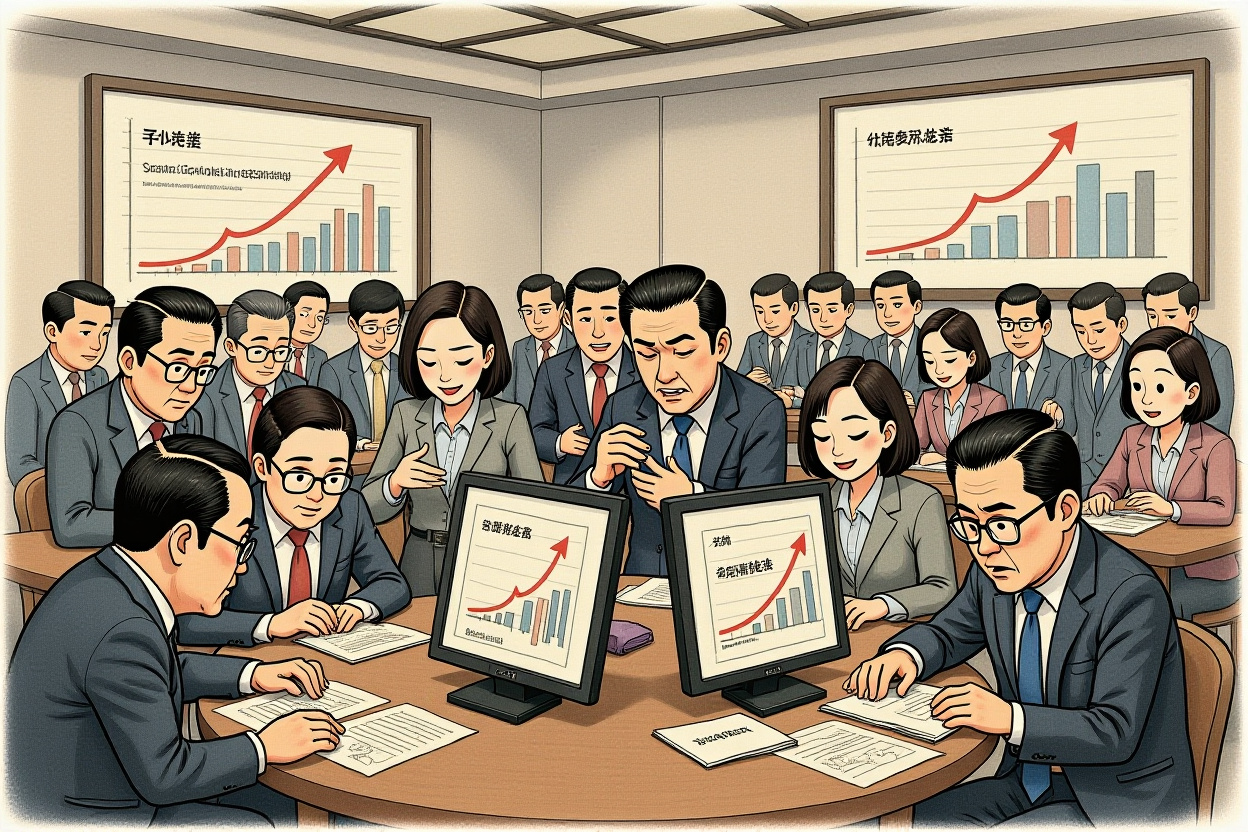Key Takeaways
– Chinese exporters face a triple challenge of tariff uncertainties, order fragmentation, and heightened competition
– Despite headwinds, China’s goods trade grew 3.5% year-on-year in first 8 months of 2024
– Market diversification and supply chain flexibility emerge as critical survival strategies
– Companies investing in digital transformation and high-value products show strongest resilience
China’s Export Resilience Tested by Global Trade Headwinds
While attending a trade show in France, Huang Fang, founder and general manager of Jida (Shanghai) Textile Co., Ltd., took a break between client meetings to share insights about the current state of China’s export economy. Her company’s participation in multiple international exhibitions exemplifies how Chinese exporters are adapting to what industry insiders now call the triple challenge of modern global trade.
The Export Landscape Today
China’s customs data reveals a complex picture of the nation’s trade performance. From January to August 2024, China’s total goods import and export value reached 29.57 trillion yuan, representing a 3.5% year-on-year increase. This growth comes despite significant headwinds including global economic recovery fatigue, rising trade protectionism, and frequent adjustments to U.S. tariff policies that have created substantial challenges for global trade.
The August figures showed particular strength with exports reaching 2.3 trillion yuan, up 4.8% year-on-year, marking the sixth consecutive month of export growth. This resilience demonstrates how Chinese exporters are navigating the triple challenge through strategic adaptation and innovation.
Understanding the Triple Challenge Facing Chinese Exporters
Chinese exporters currently confront three interconnected pressures that constitute what industry experts term the triple challenge. This trifecta of difficulties requires sophisticated responses from both companies and policymakers.
Tariff Uncertainty Clouding Business Planning
The uncertainty surrounding tariff policies, particularly from the United States, creates significant planning difficulties for export-oriented businesses. Although additional U.S. tariffs on Chinese goods have not yet been implemented, the possibility continues to loom over trade relations.
Wang Zhen, Director of the Regional Development Planning Institute at China (Shenzhen) Institute of Comprehensive Development, explains: “Tariff policy uncertainty leads to unstable expectations among foreign trade enterprises, making it difficult for companies to effectively plan and arrange production or investment.”
The impact extends beyond direct tariff effects. Liu Xiaoming, Executive President of Hebei Unider Energy Saving Technology Co., Ltd., which primarily exports insulation materials, shared a concrete example: “An American company was originally going to sign a four-year contract with us, but after tariff increases, the customer recalculated costs and found them unbearable. The contract had to be temporarily shelved.”
This uncertainty creates ripple effects across supply chains. Liu notes that tariff increases on primary products like steel reduce importers’ willingness to purchase from China, which subsequently affects complementary products like insulation materials.
Order Fragmentation Reshaping Production Models
The second component of the triple challenge involves the fragmentation of orders into smaller, more frequent shipments. Zhao Wenhong, Deputy General Manager of Quanzhou Pengtai Apparel Co., Ltd., describes how the industry has transitioned from “near stagnation” to “cautious recovery” since April, with orders becoming noticeably smaller and rhythms faster.
The era of bulk orders numbering in the hundreds of items is fading, replaced by dozens of small orders that present massive challenges to traditional production models. This shift represents a fundamental change in how global buyers manage inventory and respond to market demands.
Intensified Competition Squeezing Profit Margins
The third element of the triple challenge comes from increasingly fierce competition that compresses profit margins. Professor Bao Xiaohua, Chair Professor at Shanghai University of Finance and Economics School of Business and Chief Expert at the Chinese Modernization Research Institute, observes that against the backdrop of weak global demand, foreign trade enterprises often need to “exchange price for volume” to maintain market share.
Zhao Guoqing, General Manager of Shenzhen Medrenna Biotechnology Co., Ltd., which mainly exports infusion pumps, confirms this trend: “Some domestic peers have significantly reduced prices in the U.S. market—’willing to work as long as the factory can operate’—forcing other companies to passively follow or find differentiated solutions.”
Supply-side competition has also intensified as companies previously focused on the U.S. market pivot to other regions. Huang Fang notes: “Manufacturers that originally focused on the U.S. market are turning to Europe and other markets as U.S. orders decline. Those of us who already focused on European markets must now compete with more peers for orders and engage in price competition.”
How Chinese Exporters Are Adapting to the Triple Challenge
Despite the triple challenge, many Chinese exporters are demonstrating remarkable adaptability through strategic shifts in operations, market focus, and product offerings.
Supply Chain Diversification as Strategic Response
Forward-thinking companies are developing more diverse production footprints to navigate tariff uncertainties. Huang Fang’s textile company exemplifies this approach: “We are diversifying our production base layout as much as possible, with factories both domestically and in Bangladesh. Next year, we may place some capacity in Vietnam or Cambodia.”
This supply chain diversity provides foreign trade enterprises with more flexibility when facing tariff changes. Huang, with over 20 years in the garment industry, notes that while assembly can be relocated, upstream processes like spinning, dyeing, and weaving remain difficult to replicate elsewhere, with ASEAN countries still importing raw materials from China.
Market Diversification Strategy Showing Results
The “don’t put all your eggs in one basket” approach to market diversification is another common strategy mentioned by multiple foreign trade company executives. Zhao Guoqing reports that increased exports to emerging markets in Southeast Asia and Latin America have driven overall performance growth this year compared to the same period last year.
“We have increased staffing in ASEAN, Middle East, and Eastern Europe regions, while also increasing participation in local exhibitions,” Zhao explains.
Data confirms the effectiveness of market diversification strategies. In the first eight months of 2024, while China’s imports and exports with the U.S. decreased by 13.5% year-on-year, trade with ASEAN grew by 9.7%, and with the EU by 4.3%. Additionally, imports and exports with Belt and Road partner countries increased by 5.4%.
Digital Transformation Enabling Flexible Production
To address the challenge of order fragmentation, companies are investing in digital transformation that enables more flexible production capabilities.
Smart Manufacturing Solutions
Zhao Wenhong’s apparel company began implementing intelligent quick-response smart manufacturing services years ago, undergoing digital transformation to achieve intelligent processes from cutting, sewing, packaging, to sorting. This investment has equipped them with flexible production capacity for “small order quick response,” better adapting to current small-batch, fast-reaction production needs.
“This is an important reason why our company has achieved ‘counter-trend growth,'” Zhao notes, while acknowledging that for enterprises that haven’t undertaken technological transformation, equipment upgrades and improved digital intelligence levels mean additional time and costs.
Policy Support and Enterprise Innovation: Dual Drivers for Export Resilience
Addressing the triple challenge requires coordinated efforts between policy support and enterprise innovation, with core strategies focusing on market diversification and product variety.
Policy Recommendations for Cross-Border Supply Chain Development
Wang Zhen suggests that at the policy level, guidance should be provided for cross-border orderly layout of industrial chains, strengthening construction of comprehensive overseas service systems, building platforms for enterprises to conduct overseas investment orderly, and enhancing synergistic development of domestic and international industrial chains.
“Policy levels could explore methods like one-time filing with multiple verifications, optimizing clearance processes for outgoing materials processing, and improving clearance facilitation levels,” Wang recommends.
He further suggests that since many companies are vigorously expanding into non-U.S. markets, government departments could organize more market matching events or exhibitions to help connect with non-U.S. market customer resources. Additionally, establishing常态化 overseas exhibition and sales platforms or centers could help promote Chinese products.
Enterprise-Led Innovation and Value Creation
While policy support provides external guarantees, companies’ active adjustments and upgrades form the foundation for addressing challenges and maintaining long-term competitiveness. Wang Zhen recommends that enterprises stock goods in overseas warehouses in advance to respond to sudden tariff policy changes, and innovate trade models by separating commodity exports into “goods + services.”
For example, separating hardware and software结算 for automotive testing equipment can reduce tariff pressure on the goods portion.
Product diversification and high value-added development represent core competitive advantages for breakthrough. Bao Xiaohua recommends that while expanding into emerging markets like ASEAN, Middle East, and Latin America, enterprises should enhance product and value chain positioning, accelerate extension into high value-added fields like new energy, smart manufacturing, and high-end equipment, and strengthen competitiveness through technology and quality.
Simultaneously, early layout of green and compliance capabilities, establishing carbon footprint and supply chain traceability systems, and actively responding to new rules like carbon border adjustments can prevent market loss due to non-compliance.
The Path Forward for China’s Export Sector
Multiple foreign trade enterprises have already taken action. Hebei Unider Energy Saving Technology Co., Ltd. has abandoned the “price war” mentality and plans to build protective moats through technological innovation. Jida (Shanghai) Textile Co., Ltd. is planning to develop eco-friendly clothing.
Huang Fang explains: “Global consumers increasingly accept sustainable products and are willing to pay premiums for clothing’s environmental attributes. This is an important direction for our company to escape red ocean competition.”
Looking ahead, China’s foreign trade enterprises remain confident. Zhao Guoqing states: “Chinese infusion pumps still hold low global market share. Compared with European and American products, Chinese products offer higher cost performance in markets like Southeast Asia and Africa, suggesting significant future growth space.”
Liu Xiaoming predicts that after this year’s fluctuations, foreign trade exports may enter a period of low-speed growth in the coming years. This optimism stems from the resilience and adaptability that Chinese exporters have demonstrated in facing the triple challenge of modern global trade.
The successful navigation of this triple challenge will require continued innovation, strategic market diversification, and investment in digital capabilities. Companies that can balance these priorities while maintaining cost competitiveness will be best positioned to thrive in the evolving global trade landscape.




